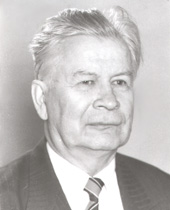Sergey Yablonsky
Sergey Vsevolodovich Yablonsky | |
|---|---|
 Sergey Yablonsky | |
| Born | 6 December 1924 |
| Died | 26 May 1998 (aged 73) Moscow, Russia |
| Nationality | Russian |
| Alma mater | Moscow State University |
| Awards | Lenin Prize |
| Scientific career | |
| Fields | Mathematics and discrete mathematics |
| Institutions | Moscow State University Steklov Institute of Mathematics |
| Doctoral advisor | Nina Bari Pyotr Novikov |
| Doctoral students | Oleg Lupanov, Rafail Krichevskii |
Sergey Vsevolodovich Yablonsky (
Yablonsky is credited for helping to overcome the
In Russia, a group led by Yablonsky had the idea that combinatorial problems are hard in proportion to the amount of brute-force search required to find a solution. In particular, they noticed that for many problems they could not find a useful way to organize the space of potential solutions so as to avoid brute force search. They began to suspect that these problems had an inherently unorganized solution space, and the best method for solving them would require enumerating an exponential (in the size of the problem instance) number of potential solutions. That is, the problems seem to require "shots in the dark" (for some constant ) when the length of the problem description is . However, despite their "leading-edge" taste in mathematics, Yablonsky's group never quite formulated this idea precisely.[2]
Biography
Childhood

Yablonsky was born in
War
In August 1942, after completing his first year at Moscow State University's Faculty of Mechanics and Mathematics, Yablonsky, then 17, went to serve in the Soviet Army, fighting in the second world war as a member of the tank brigade 242. For his service he was awarded two Orders of the Patriotic War, two Orders of the Red Star, Order of Glory of the 3rd class, and numerous medals. He returned to his study after the war has ended in 1945 and went on to graduate with distinction.
Post-war period
Yablonsky graduated the Faculty of Mechanics and Mathematics of Moscow State University in 1950. During his student years he worked under supervision of Nina Bari. This collaboration resulted in his first research paper, "On the converging sequences of continuous functions" (1950).
He joined the graduate program of the
Starting from 1953, Yablonsky worked at the Department of Applied Mathematics of
Yablonsky played an active role in the creation of the Faculty of Computational Mathematics and Cybernetics at Moscow State University in 1970. In 1971 he became the founding head of the department of mathematical cybernetics (initially department of automata theory and mathematical logic) at the Faculty of Computational Mathematics and Cybernetics.[4]
References
- ^ Sipser, M. (1992), The history and status of the P versus NP question, in ‘Proceedings of the 24th Annual ACM Symposium on the Theory of Computing’, pp. 603–618.
- ^ Computational Complexity Theory (2004), Steven Rudich, Avi Wigderson, Editors, American Mathematical Society, page 12.
- ^ История информатики в России. Ученые и их школы. Сергей Всеволодович Яблонский (2003) [1], Валерий Борисович Алексеев, Nauka Publishers, page 241.
- ^ Яблонский Biography of S. V. Yablonsky at the website of the department of Mathematical Cybernetics, Moscow State University (in Russian)



